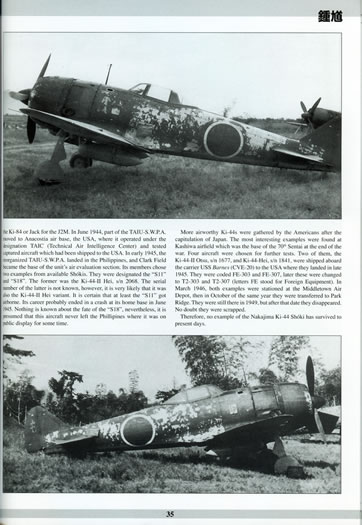S u m m a r y |
| Publisher and
Catalogue Details: |
REVI Publications NAKAJIMA KI-44 “SHÓKI” By Martin Ferkl |
| Media and
Contents: |
Soft cover, 104 pages |
| Price: |
Euro 22.00 online from Modelimex |
| Review Type: |
FirstRead |
| Advantages: |
Large format publication, fascinating assortment of photographs with informative captions, interesting text backed up by inspirational artwork |
| Disadvantages: |
|
|
Recommendation: |
Highly Recommended |
Reviewed by
Rodger Kelly

HyperScale is proudly supported by Squadron.com
For those not familiar with the name, Revi Publications hails from the Czech Republic and produces first rate magazines, decals and books that appeal to both the modeller and the aviation enthusiast.
The latest addition to their book range covers the Imperial Japanese Army Air Force’s Nakajima Ki-44 Shoki (Devil Queller) or Tojo as it was dubbed by the US Army Air Forces’ code name system for Japanese aircraft.
In general, the Ki-44 was a single radial engined low wing monoplane fighter aircraft designed for high speed and a fast rate of climb to enable it intercept bomber aircraft. This it certainly did in the closing stages of World War Two when it took on the high-flying Boeing B-29 Super Fortresses of General Curtis LeMay’s XXIst Bomber Command.
Comprehensive would be a good descriptor for this book. As for its contents, it commences with a brief discourse on the state of the Japanese military aviation industry post World War One and the formation of the Nakajima company and its pre world War Two history and then straight into the history of the Ki-44 itself.
The development of the Ki-44 is given a mere 13 pages but whilst brief it is indeed very complete.
The combat deployment of the aircraft follows and again, the coverage is very good indeed and includes the major campaigns it took part in – Burma – the Imphal operation, Indonesia, the Philippines, China – Burma – India (the best part of five pages too), Manchuria, and finally, the defence of the Japanese home islands. The short post World War Two use of the Ki-44 by the Chinese Nationalist Air Force rates a mention and considerable photographic and written coverage is also afforded to the Ki-44s captured by the US Army Air Forces’ Technical Air Intelligence Unit South West Pacific Area.
A short discourse on Ki-44 pilots awarded the Bukóshó Order, the highest decoration awarded to Imperial Japanese Army Air Force pilots is included with mention made of Isamu Sakamoto, Kenichi Fujimoto, Makoto Ogawa, and Yoshio Yoshida.
Modellers are also taken care of with a two page section devoted to information on Ki-44 kits and aftermarket decals in all scales.
Detailed technical drawings by Martin Lèbl of all variants of the Ki-44 in both 1/72 and 1/48 scale feature largely (22 pages in 1/48 scale and six in 1/72 scale) with a further eight pages of Nakajima period technical drawings as well.
Also included are 17 pages featuring full colour artwork of various Ki-44s. The artwork is first rate and covers a spread of K-44 variants and squadrons. The profiles look to be of the same aircraft that feature on the Revi decal sheet for the Ki-44 that was reviewed here on Hyperscale by Luke Pitt earlier this year http://www.hyperscale.com/2009/reviews/decals/revi48005reviewlp_1.htm
The book is A-4 in size with (very) thin cardboard covers and consists of 104 glossy pages that carry 100 period black and white photographs and 40 full colour drawings.

As a fan of World War Two Japanese military aviation I was impressed with the well laid out chronology of the development and use of the Ki44 and as well as the excellent colour profiles with the best part of all the fact that it is in the English language.
If you intend on buying the new Hasegawa 1/32 scale Ki-44 you will also want to buy this book to assist you in modelling what is a very colourful aircraft indeed.
Thanks to REVI magazine for the review sample
Review Copyright © 2008 by Rodger Kelly
Page Created 13 October, 2009
Last updated
13 October, 2009
Back to
HyperScale Main Page

